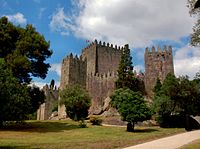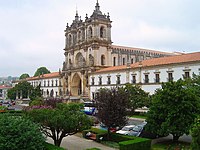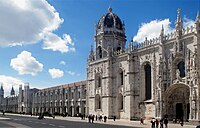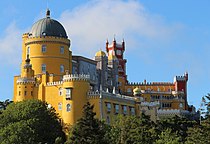
The Manueline, occasionally known as Portuguese late Gothic, is the sumptuous, composite Portuguese architectural style originating in the 16th century, during the Portuguese Renaissance and Age of Discoveries. Manueline architecture incorporates maritime elements and representations of the discoveries brought from the voyages of Vasco da Gama and Pedro Álvares Cabral. This innovative style synthesizes aspects of Late Gothic Flamboyant architecture with original motifs and influences of the Plateresque, Mudéjar, Italian, and Flemish architecture. It marks the transition from Late Gothic to Renaissance. The construction of churches and monasteries in Manueline was largely financed by proceeds of the lucrative spice trade with Africa and India.

Portuguese architecture refers to both the architecture of Portugal's modern-day territory in Continental Portugal, the Azores and Madeira, as well as the architectural heritage/patrimony of Portuguese architects and styles throughout the world, particularly in countries formerly part of the Portuguese Empire.

Pousadas de Portugal is a chain of luxury, traditional or historical hotels in Portugal. Formerly run by the Portuguese State, they are now run by the Pestana Group, which in September 2003 won a public bid for the sale of 37.6% of parent company Enatur and for a 40-year running concession. It is a member of the Historic Hotels of Europe.

Portuguese Gothic architecture is the architectural style prevalent in Portugal in the Late Middle Ages. As in other parts of Europe, Gothic style slowly replaced Romanesque architecture in the period between the late 12th and the 13th century. Between the late 15th and early 16th century, Gothic was replaced by Renaissance architecture through an intermediate style called Manueline.
The architecture of the Portuguese Renaissance intimately linked to Gothic architecture and gradual in its classical elements. The Manueline style was a transitional style that combined Renaissance and Gothic ornamental elements to buildings that were architectonically closer to Gothic architecture, as is the Isabelline style of Spain. Manueline was succeeded by a brief Early Renaissance phase, closer to Classical canons, followed by the adoption of Mannerist forms. Portuguese Mannerism, specially in secular architecture, is characterised by simplicity in the organisation of façades and relative lack of decoration, being often referred to as Estilo Chão. Even with the arrival of Baroque architecture in the late 17th century, Portuguese architecture continued to use Mannerist forms well into the 18th century.
In the Medieval Kingdom of Portugal, the Cortes was an assembly of representatives of the estates of the realm – the nobility, clergy and bourgeoisie. It was called and dismissed by the King of Portugal at will, at a place of his choosing. Cortes which brought all three estates together are sometimes distinguished as Cortes-Gerais, in contrast to smaller assemblies which brought only one or two estates, to negotiate a specific point relevant only to them.
The 2013–14 Taça de Portugal was the 74th season of the Taça de Portugal, the premier Portuguese football knockout cup competition organised by the Portuguese Football Federation (FPF). It was contested by 156 teams from the top four tiers of Portuguese football. The competition began with the first-round matches in September 2013 and concluded with the final at the Estádio Nacional in Oeiras, on 18 May 2014.

Maria Ana de Sousa Leal da Costa, is a Portuguese sculptor.

The Battle of Marvão was a military action that took place during the Fantastic War and the Anglo-Spanish War and was part of the attempted Spanish and French invasion of Portugal in late 1762. A sizeable Spanish force attacked the castle town of Marvão but was repelled and defeated by an Anglo-Portuguese force under the command of Captain Thomas Browne.
Infraestruturas de Portugal, S.A. (IP) is a state-owned company which resulted from the merger of Rede Ferroviária Nacional (REFER) and Estradas de Portugal (EP). It manages the Portuguese rail and road infrastructure.
The 2019–20 Taça de Portugal was the 80th edition of the Taça de Portugal, the premier knockout competition in Portuguese football. A total of 144 clubs entered this edition, including teams from the top three tiers of the Portuguese football league system and representatives of the fourth-tier District leagues and cups. This was the first season to allow a fourth substitution during extra time.
The 2021–22 Taça de Portugal was the 82nd edition of the Taça de Portugal, the premier knockout competition in Portuguese football. A total of 154 clubs competed in this edition, including all teams from the top four tiers of the Portuguese football league system – excluding reserve or B teams, which are not eligible – and representatives of the fifth-tier District leagues and cups.




























